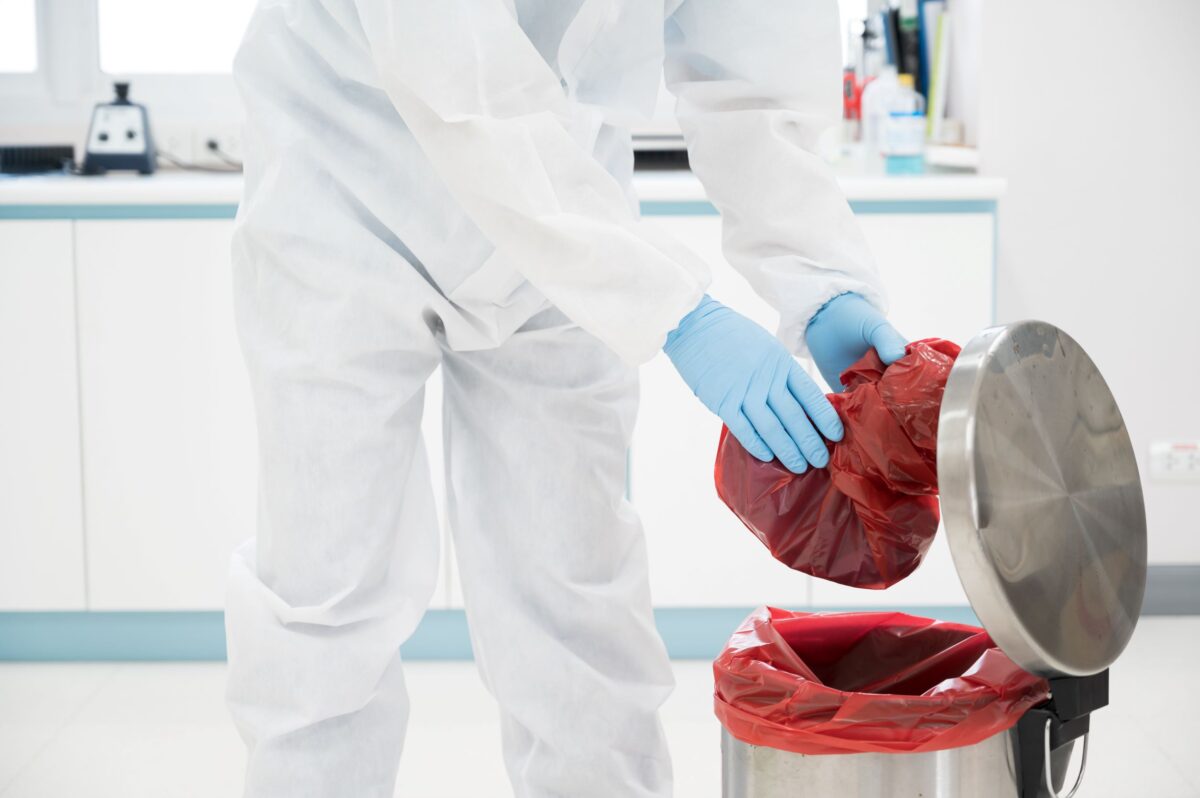The Role of Personal Protective Equipment (PPE) in Biohazardous Waste Management

Biohazardous waste, as the name suggests, poses a significant risk to human health and the environment. Proper handling and disposal are crucial to minimizing these risks, as we talked about last time. However, one often-overlooked aspect of biohazardous waste management is the role of Personal Protective Equipment (PPE). In this blog post, we will explore the importance of PPE in biohazardous waste management and its critical role in protecting healthcare workers, waste management personnel, and the general public.
Understanding Biohazardous Waste
Biohazardous waste includes materials that may contain harmful microorganisms like bacteria, viruses, and other pathogens. This type of waste is generated in various settings, including healthcare facilities, research laboratories, and pharmaceutical companies. Handling and disposing of biohazardous waste pose a unique challenge because it can carry infectious agents that can cause diseases in humans or animals. Biohazardous waste can be found in various forms, including sharp objects, contaminated materials, blood and blood products, tissues, and microbiological waste.
Risks Associated with Biohazardous Waste
Improper management of biohazardous waste can lead to several risks, including:
Infections: Direct contact with biohazardous waste or its contents can lead to infections. Healthcare workers, lab technicians, and waste management personnel are particularly vulnerable.
Needlestick Injuries: Sharp objects like needles, syringes, and scalpels can cause injuries that may lead to infections or other health complications.
Environmental Contamination: If biohazardous waste is not disposed of properly, it can contaminate the environment, potentially harming wildlife and ecosystems.
The Role of Personal Protective Equipment (PPE)
PPE is a crucial component of biohazardous waste management. It provides a barrier between individuals and the hazardous materials they are handling or being exposed to. In the context of biohazardous waste, PPE plays several key roles:
- Protection against Direct Contact: PPE, such as gloves, gowns, and shoe covers, serves as a physical barrier to prevent direct contact with biohazardous waste. These items help ensure that workers are shielded from potentially infectious materials.
- Prevention of Airborne Transmission: Some biohazardous waste may become aerosolized during handling. Respiratory protection, such as masks or respirators, safeguards against inhaling airborne particles that could contain harmful pathogens.
- Shielding against Splashes and Splatters: Biohazardous waste may contain liquids that can splash or splatter during handling. Goggles or face shields protect the eyes and face from such occurrences.
- Minimizing Cross-Contamination: PPE helps prevent the spread of infectious agents from one area to another. Properly disposing of PPE after use reduces the risk of cross-contamination.
Types of PPE in Biohazardous Waste Management
There are various types of PPE specifically designed for biohazardous waste management. These may include:
- Gloves: Disposable gloves, often made of latex, nitrile, or vinyl, are essential for protecting hands from direct contact with biohazardous waste. They should be changed and disposed of after each use.
- Gowns or Coveralls: Healthcare workers and waste management personnel wear gowns or coveralls to protect clothing and skin from contamination.
- Masks and Respirators: Depending on the level of risk, workers may need to wear masks or respirators to prevent inhalation of potentially infectious aerosols.
- Face Shields or Goggles: These protect the eyes and face from splashes, sprays, and airborne particles.
- Shoe Covers: Disposable shoe covers help prevent contamination of footwear and can be easily discarded after use.
The Importance of Proper PPE Selection and Training
Selecting the appropriate PPE is critical in biohazardous waste management. Not all situations require the same level of protection, and using excessive PPE can be wasteful and uncomfortable for workers. Proper PPE selection should be based on the specific hazards present.
For example, in healthcare settings, where biohazardous waste includes materials contaminated with bloodborne pathogens, strict protocols exist for choosing the right PPE. The Occupational Safety and Health Administration (OSHA) in the United States provides guidelines and regulations on this matter.
Equally important is training. Personnel who handle biohazardous waste should be well-versed in the correct usage, donning, and doffing of PPE. Proper training ensures that individuals know how to protect themselves while minimizing the risk of contamination.
PPE Disposal and Management
PPE, by its nature, becomes contaminated during use. Proper disposal and management of PPE are as crucial as its correct usage. Here are some key considerations:
- Secure Disposal: Used PPE should be placed in designated biohazardous waste containers, which are often labeled with the biohazard symbol. This ensures that contaminated PPE is segregated from regular waste.
- Double-Bagging: Some institutions opt for double-bagging PPE to provide an extra layer of protection.
- Follow Local Regulations: It’s essential to follow local regulations and guidelines for PPE disposal. These may vary by region and institution.
- Periodic Inspection: Waste management personnel should regularly inspect PPE containers to ensure they are not overfilled and are securely sealed.
Personal Protective Equipment (PPE) plays a fundamental role in biohazardous waste management. It serves as a crucial barrier, protecting healthcare workers, waste management personnel, and the general public from potential infections and contamination. Proper PPE selection, usage, and disposal are essential to ensure safe and effective biohazardous waste handling. Moreover, the move towards sustainable PPE options can help reduce the environmental impact of PPE while maintaining safety standards. Ultimately, PPE is a cornerstone of biohazardous waste management, safeguarding public health and minimizing the risks associated with infectious materials.
